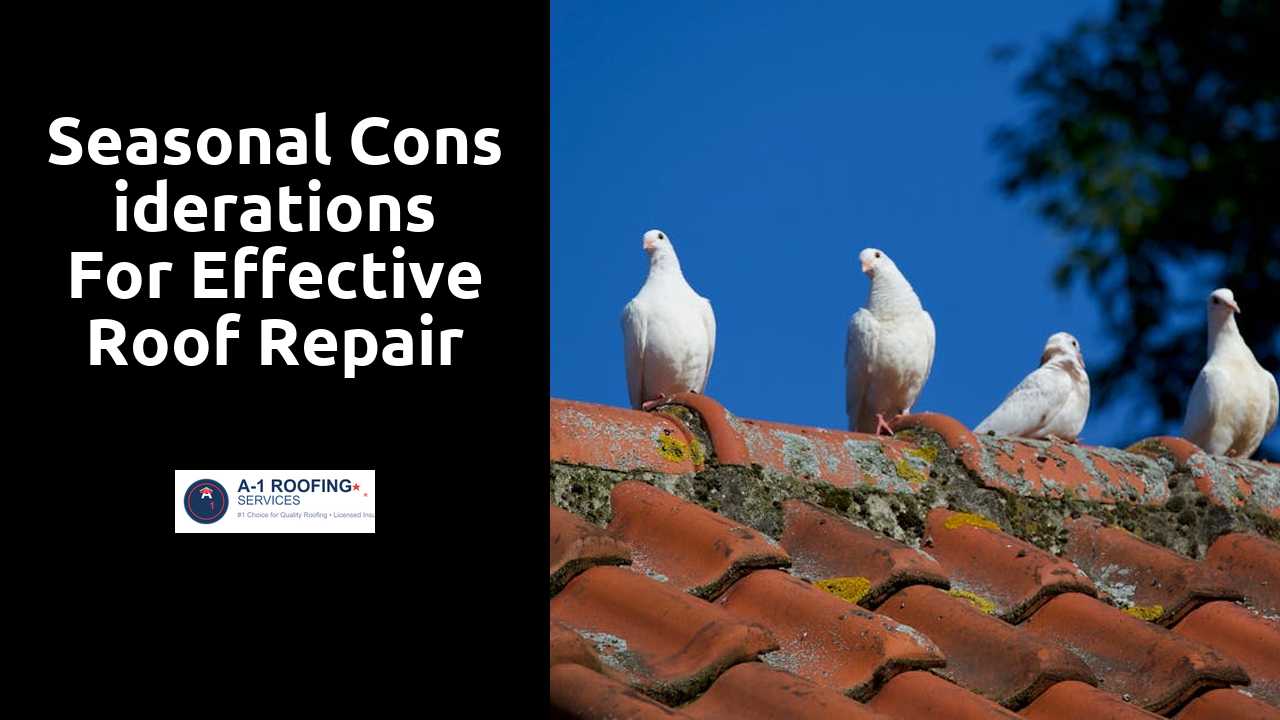
Seasonal Considerations for Effective Roof Repair
Table Of Contents
Choosing the Right Materials Based on Season
Selecting the appropriate materials for roof repairs hinges on seasonal variations. In warmer months, materials that can withstand high temperatures and direct sunlight, such as certain types of asphalt shingles, are ideal. These materials often come with UV protection, ensuring longevity against the sun's harsh rays. Conversely, winter necessitates different considerations. Products designed for low temperatures, like rubber membranes, can provide added flexibility and resistance to cracking in the cold.
Beyond temperature, precipitation patterns also play a critical role in material selection. Regions that experience heavy rain or snow require roofing that provides superior waterproofing and drainage capabilities. Metal roofing or slate tiles may be suitable options, as they excel in shedding water and snow load. Understanding these seasonal demands allows homeowners to make informed decisions, ensuring their roof remains robust and functional throughout the year.
More tips and tricks can be found here.
Material Durability in Different Weather Conditions
Choosing materials for roof repair requires an understanding of how they will react to various weather conditions. For instance, asphalt shingles offer good performance in moderate climates but may deteriorate faster in extreme heat or cold. Metal roofing can withstand intense weather, including heavy rain and snow, but may be prone to rust when exposed to excessive moisture over long periods. Depending on the material selected, its lifespan and effectiveness can be significantly influenced by the regional climate.
Tile roofs are highly durable and resistant to hail and wind, making them suitable for areas experiencing severe storms. However, their weight requires careful consideration of structural support. Wood shakes or shingles provide an aesthetic appeal but may suffer from rot or insect damage in humid climates. Understanding the specific characteristics of each material in relation to your local weather conditions ensures that repairs will be both effective and enduring, ultimately protecting the integrity of the roof over time.
Impact of Seasonal Changes on Roof Lifespan
The lifespan of a roof is significantly affected by the seasonal changes it endures. Each season introduces unique weather conditions that contribute to the gradual wear and tear of roofing materials. For instance, heavy snowfall during winter can add substantial weight to a roof and may lead to structural strain. In contrast, intense summer heat can cause materials to expand and contract, potentially leading to cracks and leaks. Understanding these seasonal impacts is crucial for homeowners looking to maintain their roofs effectively.
Regular inspections and timely repairs can help mitigate the negative effects brought on by seasonal shifts. During fall, for instance, clearing debris like leaves can prevent water accumulation, which might lead to mold growth or rot in the colder months. In spring, homeowners should assess for any winter damage, ensuring that the roof remains sound as it faces the heavy rains typical of the season. By recognizing and responding to the specific challenges presented by each season, property owners can prolong the lifespan of their roofs significantly.
Understanding Wear and Tear from Seasonal Cycles
Roofs endure significant strain throughout the year due to various weather conditions. During winter, snow accumulation can add heavy weight, leading to potential sagging or collapse, especially in older structures. Ice dams formed at the roof's edge can trap water and contribute to leaks. In contrast, summer heat can cause materials to expand, leading to cracks and degradation in asphalt shingles. Each season brings unique challenges that can shorten the lifespan of roofing materials if not properly addressed.
Seasonal cycles also affect the natural wear and tear of roofing systems. Spring's heavy rains may cause more frequent leaks if not regularly inspected, while autumn leaves can pile up, trapping moisture against the roof. These factors necessitate vigilant maintenance schedules to mitigate long-term damage. Homeowners must pay attention to the specific climate characteristics of their region to understand the most pressing threats to their roof’s integrity throughout the year. Recognizing the effects of seasonal changes helps in planning timely repairs and prolonging roof life.
Local Climate and Its Role in Roof Maintenance
Regional climates significantly influence the maintenance strategies homeowners should adopt for their roofs. Areas experiencing heavy rainfall may require a focus on waterproof materials and effective drainage systems. Conversely, regions that endure harsh winters may necessitate insulation considerations to prevent ice dams and associated damage. Understanding these nuances enables property owners to make informed decisions about the types of repairs and materials that will enhance their roofs' longevity.
Additionally, local climate patterns dictate the timing of maintenance and repair tasks. In warmer climates, roofing materials may face accelerated degradation due to increased sun exposure and heat. Seasonal inspections become crucial in these areas, ensuring that any vulnerabilities are addressed before the onset of harsh weather. Conversely, cooler regions may require pre-winter inspections to identify areas susceptible to snow accumulation and ice formation. Recognizing these regional differences is essential for preserving the integrity and lifespan of roofing systems.
Tailoring Repairs to Regional Weather Patterns
Understanding local climate conditions is essential for effective roof repair. Regions exposed to heavy rainfall require waterproofing techniques that prevent leaks and damage. Areas with extreme temperatures necessitate materials that resist contraction and expansion, ensuring longevity. Knowing the typical weather patterns helps in selecting appropriate timing for repairs. Seasonal peaks in storms or snow can impact repair schedules and success rates, making it important to plan accordingly.
The unique characteristics of regional weather should influence the choice of repair strategies. For instance, homes in humid climates may benefit from ventilated roofing options to reduce moisture buildup, while those in drier areas should focus on UV-resistant materials. Evaluating the prevalent weather conditions allows homeowners to make informed decisions that enhance the roof's integrity. Tailoring repairs to fit specific climate needs not only extends the life of the roof but also improves overall home comfort.
Related Links
Steps to Take Before Starting Roof Repair ProjectsEssential Techniques for Effective Roof Repairs